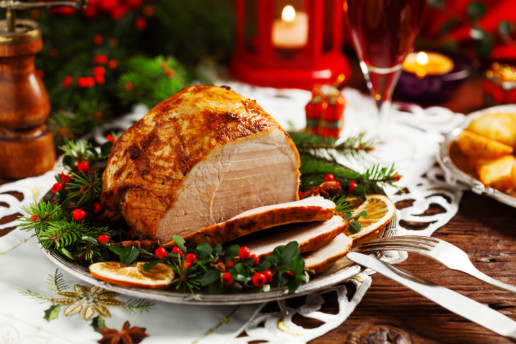Raspberry Mustard Ham with Saxon
Happy Holidays! In celebration of the holidays, the Saxon crew has decided to share one of our favorite holiday recipes for this month’s Fresh Brew! We hope you all have a safe and happy holiday season!
Christmas Ham with Raspberry Mustard
Ingredients
- 1 cup raspberry preserves
- 1/2 cup Dijon mustard
- 1 fully cooked bone-in ham (18 to 20 pounds)
Directions
- Preheat the oven to 325 degrees F. Mix together the preserves and mustard in a small bowl and set aside.
- Score the surface of the ham in a diamond pattern, about 1/8 inch deep. Bake according to the package instructions, 2 1/2 hours or longer. About 30 minutes before the cooking time is up, remove the ham from the oven and brush the glaze onto it. Cook until it’s nice and glossy. Repeat with another layer of glaze if desired.
- Serve the remaining glaze in a dish alongside the ham.

This recipe was provided by Food Network. If you’d like to visit the original source, please click here.
**Holiday Hours
- Our office will close at 12 p.m. on Monday, December 24 and will be closed on Tuesday, December 25.
- Our office will close at 12 p.m. on New Year’s Eve, Monday, December 31 and will be closed on New Year’s Day, Tuesday, January 1.
We wish you a happy holiday season filled with family and friends!
Give It A Try & Share It!

St. Patrick's Day Dinner Recipe
Originally posted on March 15, 2015 on www.firsthomelovelife.com.
Today is the day of the luck o' the Irish, the day that everybody dons their green apparel and the day that putting potatoes and meat together for a meal is smiled upon. If you are having a hard time trying to find a recipe that is festive enough for the green infused holiday look no further!
For the Potatoes
- 2 pounds potatoes
- 2 tablespoons sour cream
- 1 large egg
- 1/2 cup cream
- shredded sharp cheddar cheese (to top)
- salt and pepper
For the Mixture
- 1 tablespoon olive oil
- 2 pounds ground beef or ground turkey
- 5 large carrots, peeled and chopped
- 1 medium yellow onion, chopped
- 2 tablespoons butter
- 2 tablespoons all-purpose flour
- 1 cup beef stock
- 4 teaspoons Worcestershire sauce
- 1 cup ketchup
- 2 cups frozen peas
- 2 cups frozen sweet corn
- 2 cups frozen green beans
- 2 cups sliced white mushrooms
- salt, pepper and paprika
Directions
- In a large pot, boil the potatoes in salted water until tender, about 10-12 minutes. While the potatoes cook combine the sour cream, egg and cream into a measuring cup and mix. Drain the potatoes and pour them into a large bowl. Add the cream mixture into potatoes and mash until potatoes are to the consistency you like (I leave them a bit chunky). Set aside.
- Preheat a large sauté pan or skillet over medium high heat. Add oil to hot pan with beef or turkey. Season meat with salt and pepper. Brown and break apart meat for 5 minutes. Add the chopped carrots and onion to the meat. Continue to cook for another 5 or so minutes…
- In another small skillet over medium heat cook butter and flour together until it makes a dough like consistency. Whisk in broth, ketchup, and Worcestershire slowly, working out all the lumps.
- Add frozen veggies into the skillet with the meat.
- Add sauce to the pot and mix everything together well.
- In a large lasagna dish or something similar add the meat mixture.
- Spread potatoes evenly all over the top, sprinkle cheddar cheese on top of potatoes and garnish with paprika (optional)
- Put the shepherds pie under the broiler until the cheese has melted and bubbled, and potatoes have browned a bit.
Read full article here.
Copyright © 2015 First Home Love Life | www.firsthomelovelife.com
Christmas Tree and Holiday Light Safety
Source: National Fire Protection Association
Christmas tree fires
In 2007-2011, U.S. fire departments responded to an estimated annual average of 230 home structure fires that began with Christmas trees. Home Christmas tree fires caused an average of six civilian deaths, 22 civilian injuries, and $18.3 million in direct property damage per year.
Although these fires are not common, when they do occur, they are unusually likely to be serious. On average, one of every 40 reported home structure Christmas tree fires resulted in a death compared to an average of one death per 142 total reported home structure fires.
Similar shares of home Christmas tree structure fires were in December (43%) and January (39%). Christmas tree fires are more likely after Christmas than before. For example, none of the ten dates with the largest shares of home Christmas tree structure fires were before Christmas.
Electrical failures or malfunctions were involved in one-third (32%) of the home Christmas tree structure fires. One in six (17%) occurred because some type of heat source was too close to the tree. Decorative lights on line voltage were involved in 12% of these incidents. Sevenpercent of home Christmas tree fires were started by candles.
Twenty percent of home Christmas tree structure fires were intentionally set. Half of the intentional Christmas tree fires occurred in the 20 days after Christmas.
The risk of fire is higher with natural trees than artificial ones. Researchers found that dry natural trees burned easily but trees that had been kept moist are unlikely to catch fire unintentionally.
Fires involving holiday lights or other decorative lighting with line voltage
Holiday lights and other decorative lighting with line voltage were involved in an estimated average of 150 home structure fires per year in this same period. These fires caused an average of nine civilian deaths, 16 civilian injuries, and $8.4 million in direct property damage per year. Two out of five (40%) occurred in December and 12% were in January. Fifteen percent of these fires began with Christmas trees. Electrical failures or malfunctions were factors in nearly two-thirds (64%) of the fires involving holiday or decorative lights.
Falls related to holiday decorating
In a study of fall-related injuries during the holiday season, Stevens and Vajani estimated that an annual average of roughly 5,800 fall injuries related to holiday decorating were treated at hospital emergency rooms between November 1 and January 31 in 2000-2001, 2001-2002, and 2002-2003. Sixty-two percent of those injured were between 20 and 49 years of age, compared to 43% of the population in this age group. With 43% of the injuries resulting from falls from ladders and 13% caused by falls from the roof, it appears that the majority of these falls occurred during outdoor decorating. Falls from furniture, typically inside the structure, accounted for 11% of the injuries. Some falls occurred when people tripped over or slipped on tree skirts or other decorations.
The Cheapest Days To Fly For Christmas
Source: Business Insider
If you're traveling for Christmas this year, you've probably already started researching flights for you and your family.
This process can leave you feeling a bit like you're on a mining expedition, sifting through mountains of junk in the hopes of finding that rare gem of a deal.
Our number crunchers here at CheapAir have simplified what can be an overwhelming process in order to clearly identify which dates of travel offer the best overall value.
Here's what we've unearthed*:
Cheapest departure days: Thursday December 18th, Wednesday December 24th, Christmas Day
Cheapest return days: Wednesday, December 31st, Tuesday, January 6
Cheapest overall itinerary: Thursday, December 18th to Christmas Day
Cheapest "practical" itinerary: Wednesday, December 24th to Wednesday, December 31st
Average savings flying on the cheapest departure days: $101
Average savings flying on the cheapest return days: $142
(*average savings compared to most expensive travel days)
As you calculate the overall monetary cost of your flight, don't forget to factor in intangibles like convenience and weather when choosing an air itinerary this holiday season.
Sometimes the lowest ticket price is not always the best overall value if you look at things a bit more with the big picture in mind.
10 ways to limit holiday party liquor liability
The holiday season is upon us, and if you’re planning a company party or awards banquet, you might want to give some thought to your policy on alcohol.
Serving employees alcohol at company-sponsored parties and events can have serious and sometimes tragic consequences for your workers and your organization.
For example, if an employee drinks too much and gets into an accident on the way home, you could be held liable. Plus, sexual harassment complaints tend to increase when alcohol consumption goes up.
Here are some suggestions to help prevent alcohol-related problems—including sexual harassment and auto accidents—and limit your exposure to liability if you do decide to serve liquor:
- Don’t serve liquor. The simple solution to the problem is not to serve alcohol at all—though this may not be realistic.
- Limit consumption. You may be able to limit the amount people drink by having a cash bar or by providing tickets good for only two or three drinks. Also, stay away from sweet punches containing alcohol. These can make it difficult for people to tell how much alcohol they have consumed—until it’s too late.
- Close the bar early. One to two hours before the end of the event, stop serving alcohol. If possible, continue serving food even after the bar is closed.
- Have the party off-site. If the party takes place at a hotel or restaurant with a liquor license—and the facility’s employees serve the drinks—you’re less likely to be held responsible.
- Establish an alcohol policy. Institute a company policy to let your employees know that excessive drinking at company functions will not be tolerated. Also remind workers about the dangers of drinking and driving.
- Offer transportation. Make taxi vouchers available to provide the option of cab rides at company expense.
- Avoid company business. To help make the event a social affair, keep any discussion of business to a minimum and hold the party outside of regular business hours.
- Make company functions voluntary. It’s a good idea to make attendance at company parties where liquor is consumed entirely voluntary.
- Invite families. Inviting spouses and dates tends to make the event more of a social occasion rather than a business function.
- Don’t invite customers, clients, or business associates. Inviting the people your company does business with increases the likelihood that the event is an official company function.
- Watch for minors. The law can come down hard on you if you allow minors to drink alcohol. If a significant number of your employees are minors, or if you expect families to attend (e.g., the event is a company picnic), consider serving no alcohol at all.
Although it’s impossible to exercise absolute control over your employees, the key to avoiding liability, as well as keeping workers safe and out of legal trouble, is to do everything you can to prevent them from drinking too much and getting behind the wheel.

